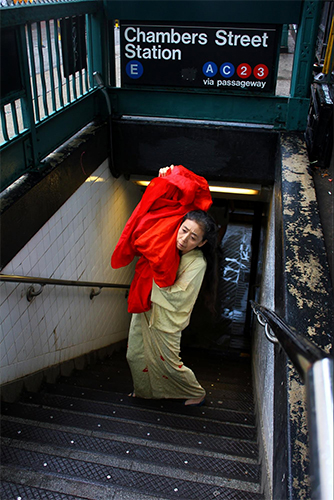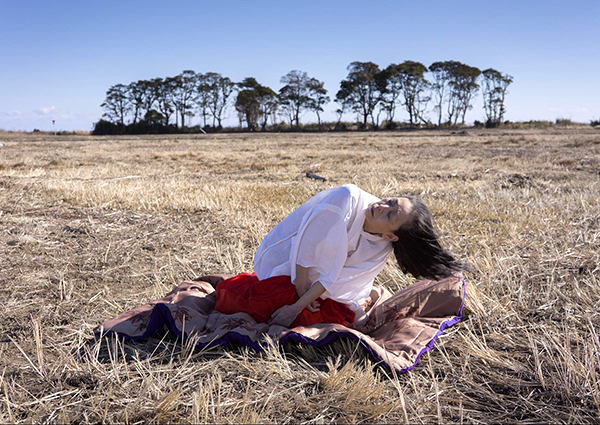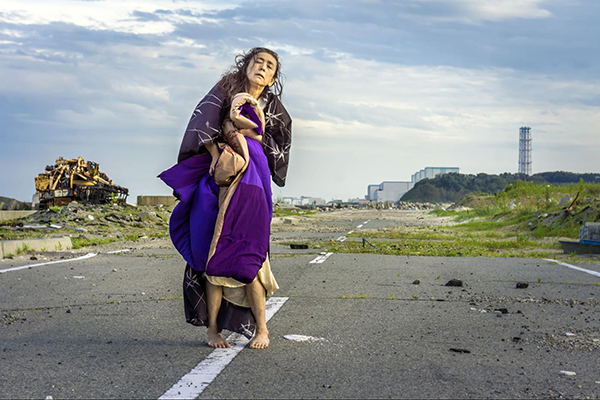
Eiko Otake dances with a stillness at once excruciating and exquisite. Her work is a negotiation of precision and flow, withdrawal and surge, shyness and exposure. For much of her career, she has danced as half of a duo, Eiko & Koma, with her partner in performance and life, Takashi Otake. Her first solo performance, which took place just last year, was titled A Body in Places; it has so far included “A Body in a Station,” put on at Manhattan’s Fulton Center, and “A Body in Fukushima,” a photo series in which Eiko’s movements are documented against a landscape made desolate by the Fukushima Daiichi nuclear disaster. As Eiko notes in the following interview, “I am using my body as a constant.”
Eiko Otake and Takashi “Koma” Otake met in Tokyo in 1971 as students at an avant-garde theater company run by Tatsumi Hijikata, a choreographer and co-founder of the performance genre Butoh. Eiko and Koma’s partnership, which began as an experiment, has lasted for over forty years. They settled in New York in 1976 and toured often, performing at museums, theaters, and festivals. They also staged free, public outdoor performances to take their work beyond the confines of traditional art spaces. In 1996, they became the first collaborators to jointly receive a MacArthur Foundation “genius grant.”
Eiko is deeply serious about her art, but less so about herself. As she explains, she occasionally delights in “playing the nuisance” and “personifying the maggot.” Her irreverence and playful nature seem to necessarily coexist with the sometimes devastating subject matter she addresses in her work.
In both her projects as part of Eiko & Koma and her solo venture, Eiko embodies experiences in order to cultivate empathy in her audience. Within her, the maggot, the artist, and the political actor all agitate toward truth. Up to a year prior to the September 11 attacks, Eiko & Koma had worked in a studio space on the 92nd floor of the World Trade Center. In the aftermath of 9/11, the two began a series of performances, first in and around New York and then across the US, entitled Offering, which can be read as an attempt to confront their own grief as a means of unlocking grief in others. In “A Body in Fukushima,” a lone overture, Eiko forms another dialectic arising out of fear and the necessity to go where a body should not be. By asserting life in a place where its absence is palpable, she evokes the title of the 2011 book about her work with Koma by Walker Art Center: Time Is Not Even, Space Is Not Empty.
I spoke with Eiko at her Manhattan apartment. She was preparing to board a train bound for Wesleyan University, where she is currently participating in a three-year residency and co-teaching a class on the atomic bomb with her photographer-collaborator from “A Body in Fukushima,” the historian William Johnston. Before we parted ways, she began to form rice balls to make onigiri for her train journey. She handed me one, still warm in its plastic wrapper. I hoarded it and consumed it hours later in my own apartment. “Rice,” Eiko says, “tastes amazing when you’re hungry.”
—Jill J. Tan for Guernica
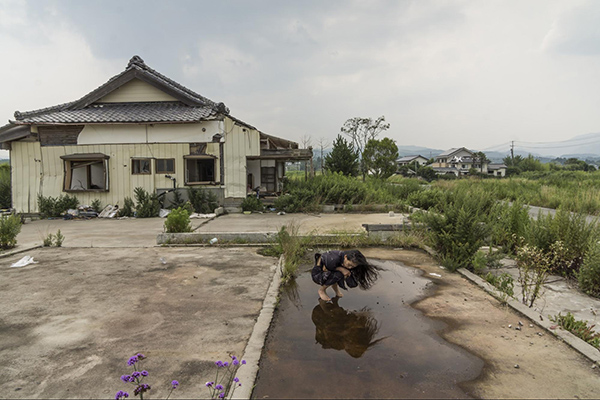
Guernica: Can you tell me about your upbringing in Japan?
Eiko Otake: I was born in Japan in 1952 and left in 1972. I returned for a year and a half between 1974 to 1976, then came to America in 1976. I had lived in Japan until I turned twenty, so those were my formative years. I don’t think I aspired to be a dance artist. From childhood, I was more of an aspiring writer, though I was more interested in journalistic rather than purely artistic work. That, however, had a lot to do with the time in which I grew up, when Japan was politically teeming. I had participated in the late-sixties student movement as a high school and college student.
As for my artistic influences, my grandfather was a painter—a rather scandalous and well-known one in his time, but not beyond it. He died before I was born, but my family talked about him a lot. My uncles were painters and designers, so there was a proximity to art in my early years. I was kind of a bookworm until I became “on the street” political in my late teens, so I think my relationship to art came through visual arts and reading. As a wannabe writer, however, I felt I had nothing important to write about because my own life hadn’t really happened to me yet.
In retrospect, that feeling prompted me to be rather brave in starting to live and work with Koma and leaving Japan. I wanted to experience something singular that I couldn’t shake out. I did not intend to be a dance professional, but I wanted to find something I could write about.
I think my actions or decisions always arise as antidotes.
Guernica: When you started dancing, you studied with arbiters of the Japanese avant-garde dance movement of the 1960s, such as Tatsumi Hijikata and Kazuo Ohno. Did you decide to study with them primarily to gather material for your writing?
Eiko Otake: I think my actions or decisions always arise as antidotes, from some frustration or ways in which I wish to be antagonistic toward something I come into contact with. I was involved in political circles and got really tired because of the sectarianism. The fights between the sects in the new left were becoming fiercer than their fights with the government or corporations, and I was very disillusioned. Looking back, I was too young to be involved in such intense political thoughts and actions. It was hard for me emotionally.
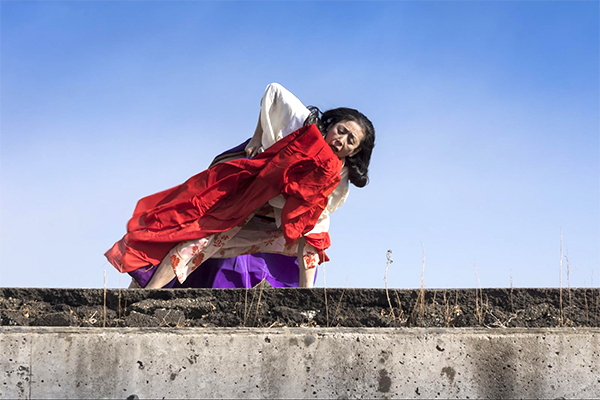
Then, almost coincidentally, I saw Hijikata’s work and was surprised. Using the body as a central axis rather than as a tool, like in theater and political demonstrations, was fresh. At the time, I was also realizing that everything I was reading and saying seemed not to be my own words—I was borrowing other people’s phrases from books. Having come from politics, going into dance was a way of doing something I’d never done before. It was an adventure. Yet it was a little bit of an escapist choice at the time.
Guernica: Tell me about your creative and life partnerships—your work as Eiko & Koma, and also the husband-and-wife artists Maruki Iri and Maruki Toshi, whose Hiroshima Panels [painted folding panels depicting the consequences of the atomic bombing] you recently performed alongside.
Eiko Otake: I was moved when I visited the gallery that houses their works. I was touched seeing a video that depicted the Marukis’ creative process, though of course I don’t want to make too direct of a comparison between them and Koma and me. Working with Koma was an experiment. I liked it because I wasn’t ready to work alone; I didn’t yet have the tools. I am three and a half years younger than he is, which was huge when we first started to work together. He had much more life experience, and I was intimidated. But we were very different people and soon I learned to argue and respond. We have always argued a lot in working together, just as the Marukis said about themselves.
What’s good about this whole collaboration process is that it creates layers. It’s not like having an idea of one’s own and just working on it. That’s not enough layers, often, when the work carries a heavy theme. Because Koma and I are performance artists, our preparation “disappears,” so we are not able to show that layering process as clearly.
We have to be pretty independent within our own performances: in one evening, there’s my solo, Koma’s solo, and then a duet. In our solos, he does not choreograph me nor I him. He serves as an eye, and may comment, but it’s entirely up to me to take it up.
The weight in our relationship is pretty equal. There are certain things he is better at, like set-making—he is very visual and has that singular focus—while I did much more conceptualizing, responding, writing, and finding a structure and core of the work. I also did a lot of management work. But when we are onstage, it is never like a work is more strongly created by one of us. We worked this way for forty years. It’s only now that I’m working on my own. I don’t know why it took me so long but I think it’s because I continued to find challenging work as part of Eiko & Koma, so I felt I was working with my own voice and body even in that context. Now this is a new step for me, even though I’m still the same person as the one I’d already become a long time ago.
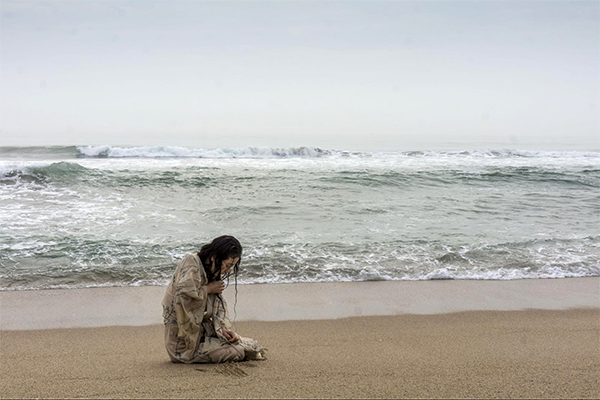
Guernica: Can you walk us through your creative process?
Eiko Otake: As Eiko & Koma, often, if not always, Koma would have a strange idea, and I would then bring in certain materials to build on and discuss the idea. Sometimes what each of us brings connects, and usually I come up with a title that reflects that. He may talk about eating rice, for example, and then I bring to the table some literature on how the body dies, and mythology on grain and rotten bodies. From there, I suggest making a piece about grain. Koma may have been talking about rice, but by naming it “Grain,” there is suddenly a level of abstraction. Now, with two Asian bodies eating cooked white rice spread across the space, it becomes a very kinesthetic image. We have to design the set and do the movement, but once we have the universal myth of the grain and the body, we have the core of the piece.
In my current project, working alone, I don’t do this. The whole project is about my body in different places. I am using my body as a constant. When I perform in a station, I address the station: the piece becomes my duet with the station. Throughout, there are people watching, so I am dancing for each person, with each person. The premiere of my solo work was at the Philadelphia Station, and I had to sit there for a long time watching, asking myself how I would move in the space and who I would be moving past. I choreograph depending on the place and work with it. But my thinking and process are not seen during the performance. Viewers do not need to know my process and choices, but as a performer, I need the preparation in order to arrive at the moments of a performance.
I do not aspire to a dancer’s body. Mine is the body of any other woman from Asia.
Guernica: How do you develop these layers as a solo artist?
Eiko Otake: I think I develop them in performance when I am looking at each person. So the layers here are not as much about how I am dancing as how I am looking. If I’m looking at someone, someone else is looking at me looking at her, so that’s a layer. When I move on to the next person, she is aware not only that I am doing so but that time has moved on, so time gets layered. I intend to look at every single person and to catch their eye. This depends on how intimate the space I perform in is. If all I focus on is the movement, I get self-involved. So these layers come from me performing almost spontaneously, but gathering what is accumulated during the performance.
Another layer is that, as a single person moving, people look at me and project their imagination onto me: “She looks like my grandmother,” “She looks like someone in a hospital.” People look at me a certain way because I have a kind of broken body—I do not have an Olympian’s body. I am not in sync with the ideal of a healthy body. My ability to be athletic is minimal. I foreground my weak body as my thinking body, and pose the question of why people think that healthy bodies are the only ones worth watching. The perception that viewers have of me is another layer. Sometimes I carry that image, and sometimes I subvert it with strength, which prompts surprise, a sort of drama.
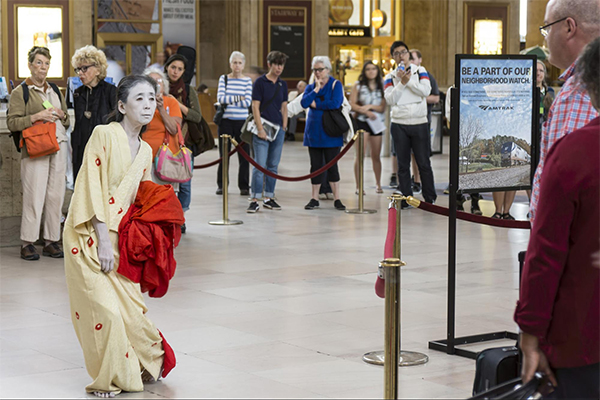
I do not aspire to a dancer’s body. Mine is the body of any other woman from Asia. I don’t even want to emphasize the Japanese part, nor do I particularly want to use it as a woman’s body. I want to put forth a body which is useless but wants to be useful.
Sometimes my audience members talk about “silence” in my performance. For example, two librarians wrote that the library had never been so quiet as when I performed. But I do not think the library was actually quieter. A library is a quiet place. But a performance is both a kinesthetic and visual experience so one sees more, and one feels more during a performance. So viewers notice and see the “silence,” which I think is profound in adding layers of experience to being in a place.
Guernica: Some of your work spans hours, and some pieces are set in conditions of physical discomfort. There’s a tension between luxuriating in the moment and engaging with that discomfort. What is that experience like for you?
Eiko Otake: When I perform, I want to go to a place where I can be emotionally engaged in complexity and transformation, because that’s what art is to me. I want the audience to feel that the time we spend together is governed by different values than in everyday life. No counting of money or making a shopping list.
How do we get to that place of transformation? By tapping into pain and awareness beyond the experience of our own pleasure, surrendering our bodies to something else. The density of the world is due to our memories, possibilities, desires, and frustration, our many layers of problems, and the impossibility of fixing them, so all that density lives in and around our bodies and how they move through time and space.

In order to experience what I call the “grotesqueness of time,” I think it’s important to experience the potential pain that our minds and bodies carry. We have an inkling that there are things that are very hard in this world and not seeing them is escaping from them. I need to go there and face them. I move in a way that attenuates the fact that time is not even and space is not empty, and which taps into collective memory. I am not interested in my story. I need to carry this complexity and density of experience that goes beyond my own.
As a single body, if there is somewhere important for me to be, I must go. Going to Fukushima is very different from just reading about it. Not everyone should go there because it is very radioactive, but for me, it was important for me to be there. Still, I really was stunned by how upset my body felt. I could imagine it before but now that I have gone there, I cannot forget.
I am an artist but I am also a citizen. I feel like I shouldn’t be consumed by creating art which shields me from the real world, which I am often capable of doing. One of the reasons I left a theater convention for this project is that I get very happy creating better-looking and feeling work in the theater—I can improve the light, the sound, to make things more beautiful. By not being in the theater, I’m in a situation where I do not have the capacity to improve my surroundings. I want to be more present to that reality.
Guernica: Making “A Body in Fukushima” left you physically exposed to nuclear radiation; in “A Body in Station” at the Fulton Center, the crowds surged as you moved through the station and some people got very close, sometimes inches from your face. How do you navigate exposure and vulnerability?
Eiko Otake: I want to be clear: I never want to present myself as a danger-seeking artist, especially being somewhat of a senior in my field. I sometimes feel like my generation, who grew up in the late ’60s, has never quite grown up because we resisted many of the decisions associated with becoming adults. To be danger-seeking is very bad, especially for a dancer.

I went to Fukushima, and it was bad for me—I don’t deny that. At the same time, I was not twenty-two years old. Many children were exposed to much more radiation involuntarily, and I went only for a short time in 2011 and twice more in 2014, three years after the cataclysm. Once I was there, I was frightened, though I made no attempt to be too courageous. The first day, I was afraid. On the second day, I was less so, but by the fifth and sixth days, I was aware that I was leaving soon and wanted to do all the things that I could so that I would leave with few regrets. I regret that I covered myself with radiated piles of leaves.
We are often stuck between not wanting to be danger-seeking and not wanting to regret having lost an opportunity. This might work artistically, but it is a dangerous human trail, and of course bad for my health. We humans get used to a danger and begin to worry less and desire more.
As for vulnerability to the crowd in “A Body in a Station,” that’s by design—it is the essence of this piece. When vulnerability to the crowd becomes a danger, it’s different, because I don’t necessarily want to cross that line. At the same time, it’s important to me that I don’t always perform with a safe distance between me and the crowd. I like navigating the boundary of realizing they’re really close and being able to run away from them. If I don’t do that, what’s the point of performing in such a place? The place comes with the crowd. So I deal with the crowd by going very close to them, or sometimes letting them come very close to me. Yet I have control, as I can leave the crowd and wait till they come back to me, and that is my choreography, in a way.
It is the viewers who make a dancer a performer and her movement a performance.
Guernica: Do you think making art is about pushing into that space, even if it’s not exactly safe?
Eiko Otake: It’s not just me. Think about all the visual artists who use hazardous materials. We are vulnerable to our own desires, and one person’s line is different from another’s, but that line within the same person changes, too. Every artist, every scientist, every mother grapples with this: “Where is my boundary?”
The line is not solid, and sometimes determined by one’s own discipline, but often bound by available choices and which direction one is looking and how calmly. Sometimes, at the train station, I’d be very close to people and other times I’d be invisible amid the crowd, so what I’m gaining and losing also shifts. That’s what’s beautiful about being outside the theater: I lose control, but I try to work with that.
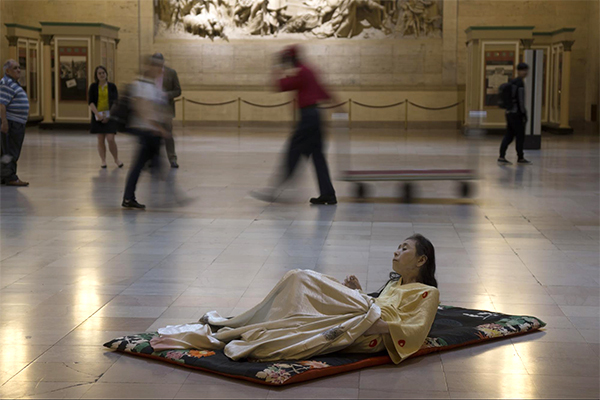
At Philadelphia Station, where the piece premiered, I was first shocked that I did not gain much attention from the passersby during the rehearsals. When I realized not many people were watching me, I wondered why. I then realized it was because people thought it was a photo shoot rather than a performance. Only when movement is watched by people does it become something to be watched. It is as John Cage defined music: as sound conceived to be heard. If I’m not presenting my movement as something to be seen, nobody thinks of it as something they want to watch. What is not considered interesting is seen as not interesting. But if there were enough people already watching me in a performance, it signaled to the passersby that something was happening that they might want to pay attention to. It is the viewers who make a dancer a performer and her movement a performance.
Guernica: What do you struggle with, and what gives you pleasure?
Eiko Otake: Pleasure comes when desires are being met. A bowl of rice tastes amazing when you’re hungry. When I saw the photographs from Fukushima, I didn’t want to look at them because that whole experience was hard for me. But once I had a little time to digest it, when I looked at those photographs, I recognized their substance, which came about precisely because of what a hard time I had been having. I didn’t do anything special there; it is the same Eiko with her dance. But what made it special for me was the context of the place and what had happened there before I was there. My disgust and shock while being there despite knowing the situation beforehand made dancing there memorable. I was crying a lot and I felt I couldn’t move. I wanted to leave and go home. It took me a long time before I could prompt myself to dance. I remember that sense of being totally overwhelmed—and to this day I am still overwhelmed—and that, strangely, gives me some satisfaction when I look at those photographs as something that came out of such difficulty.
When someone shares with me their experience of something profound that happened to them at one of my performances in a way that does not seem like flattery, that gives me deep pleasure. I’m not working to please, but to connect. We are not changing the world that much, but we are engaged in something human—dancing, watching, planning, befriending the security guards who work at a station.
I certainly think a big city like this could use those human acts. When I’m walking in the East Village and I see young artists filming something, I have a little smile thinking of how those people are just watching the street in their own creative, imaginative eyes. By imagining what they are seeing, I am that much richer. It doesn’t cost me anything to imagine. These are all no-cost acts in which we can engage, and it makes my city my city, and it makes my place my place.
